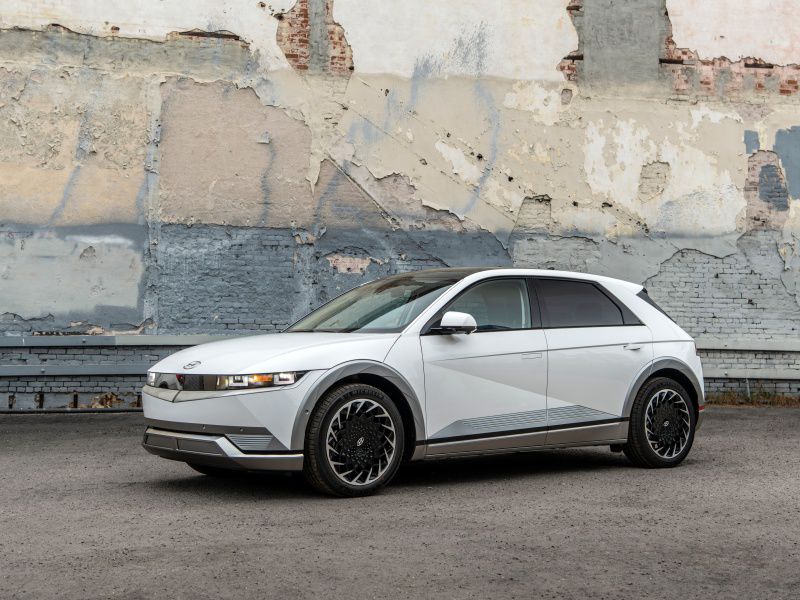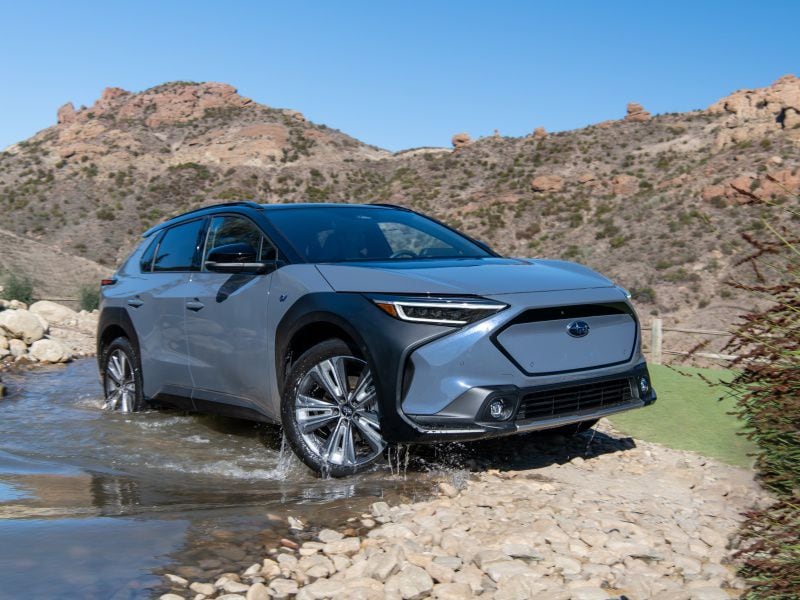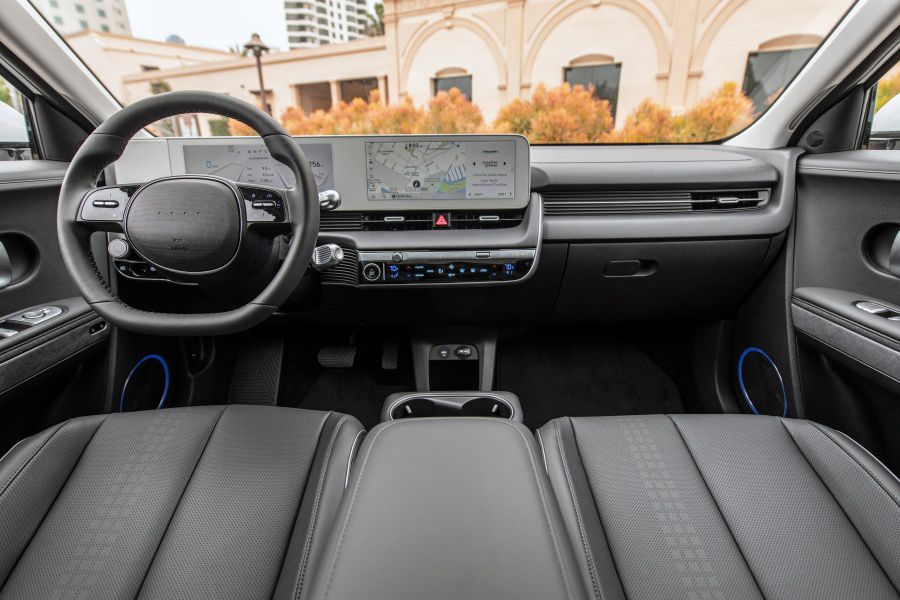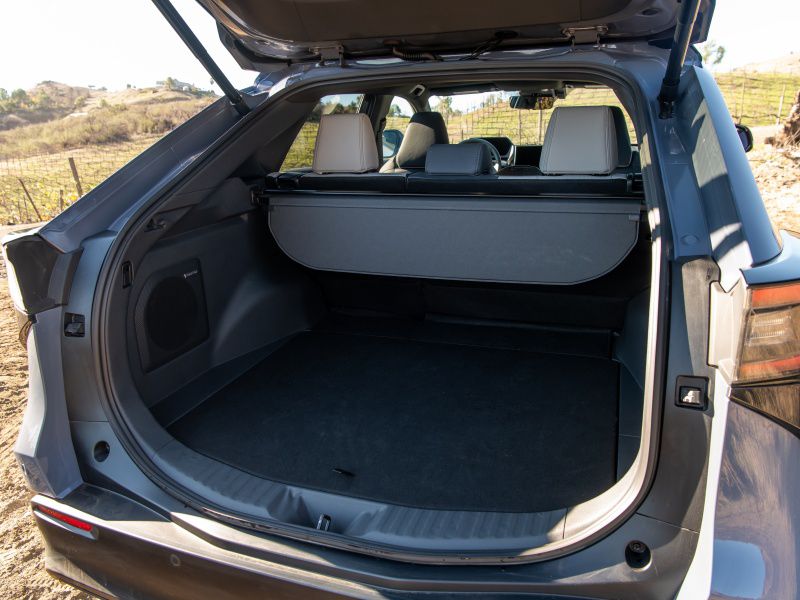Recent Articles
Popular Makes
Body Types
2023 Subaru Solterra vs. 2022 Hyundai Ioniq 5

2023 Subaru Solterra ・ Photo by Subaru
The 2023 Subaru Solterra is an all-new electric vehicle. It has seating for five with good off-road capability and standard all-wheel drive. It also has a comprehensive infotainment system and good standard safety features.
The 2022 Hyundai Ioniq 5 is also an all-new electric vehicle with seating for five people. It offers a long driving range with a choice of three trims and either rear-wheel or all-wheel drive. These two electric SUVs have a lot in common, so let’s take a closer look to see which is the better of the two.
Three Trims With Lots of Standard Features
The Hyundai Ioniq 5 offers rear-wheel or all-wheel drive across a range of three trims. The SE starts at $43,650 with heated front seats and a 12.3-inch infotainment touchscreen. The SEL is priced at $45,900 with wireless charging and a handsfree liftgate. At the top of the lineup is the Limited at $50,600 with Bose audio and ventilated front seats.
The Subaru Solterra also has three trims starting at $44,995 for the Premium. At the top of the lineup is the Touring. It’s priced at $51,995. All-wheel drive with X-Mode and Grip Control, and an 8.0-inch infotainment touchscreen are standard. The Ioniq 5 gets the win for it’s more affordable pricing.
: Hyundai Ioniq 5

Photo by Hyundai
One Prioritizes Performance
The Subaru Solterra is available with all-wheel drive only and a total of 215 net system horsepower. This provides strong acceleration and makes passing slower moving vehicles at highway speeds a breeze, but it’s not overly engaging.
The Hyundai Ioniq 5 with rear-wheel drive has a short-range battery and 168 horsepower, which falls short of the Solterra. Choose the long-range battery and the tables turn with 225 horsepower equipped with rear-wheel drive or 320 horsepower for all-wheel drive.
: Hyundai Ioniq 5

Photo by Hyundai
Off-Road Capability With Electric-Vehicle Efficiency
Those who plan more rigorous adventures will want to opt for a model equipped with all-wheel drive. You can get that in either of these EVs, but the Subaru Solterra offers a bit more. The full line-up features X-Mode with Grip Control.
This lets you handle terrain that the Ioniq 5 simply cannot manage. It takes the Solterra up steep grades with loose gravel surfaces. Hill descent control makes it just as easy to come back down those same hills. A bonus is 8.3 inches of ground clearance for climbing over uneven surfaces.
: Subaru Solterra

Photo by Subaru
Which Has a Longer Range?
Range is always a concern with an electric vehicle, and both of these SUVs have more than enough miles on a single charge to cover a typical day’s worth of driving. Where range truly makes a difference is when you’re heading out on a road trip.
The Hyundai Ioniq 5 with the short-range battery gets up to 220 miles of range per charge. The larger battery delivers up to 303 miles per charge. The Solterra has a range of 222 miles per charge in the top two trims of the Solterra, but 228 miles per charge in the base trim. That’s considerably less than what you can get in the Ioniq
: Hyundai Ioniq 5

Photo by Hyundai
Both Can Use DC Fast Charging
No one wants to sit around waiting for the battery to finish charging enough to finish the trip. Both of these EVs can use Level 1, Level 2, or DC fast charging, but charging speeds are not the same.
The Solterra charges from 10 to 80 percent at a DC fast charger in about 56 minutes or 9 hours at a Level 2 charger, which is typically what is used at home. The Hyundai Ioniq 5 takes less than 7 hours to charge at a Level 2 charger. It can also go from 10 to 80 percent in 25 minutes, but using a fast charger that number falls to 18 minutes. Hyundai comes out ahead on charging.
: Hyundai Ioniq 5

Photo by Hyundai
Ample Room for Passengers
There’s seating for five people in the Solterra with comfortable seats and room to spread out. The rear seats can fit three adults but are best for only two on longer trips. There’s also good legroom, but headroom is only 35.3 inches, which may be too low for taller passengers.
The Hyundai Ioniq 5 also has an attractive interior with seating for five. It’s open and airy with ample rear seat room. While both are spacious, the Ioniq 5 has up to 38.7 inches of rear headroom making it a better choice if passenger room is a priority.
: Hyundai Ioniq 5

Photo by Hyundai
The Capacity to Carry Everything You Need
The Hyundai Ioniq 5 has 27.2 cubic feet for cargo behind the rear seats. There are also 60/40 split-folding rear seats that make it easy to stow longer items. There’s even 0.85 cubic feet in the frunk since there’s no engine up front.
There’s up to 29.0 cubic feet for cargo behind the rear seats of the Subaru Solterra. Those seats also split-fold 60/40 for more versatility when you have longer cargo or want to make use of the rear seats for passengers at the same time. Even without a frunk, the Solterra comes out ahead.
: Subaru Solterra

Photo by Subaru
Infotainment That’s Easy to Use
The Ioniq 5 has a standard 12.3-inch touchscreen along with Apple CarPlay and Android Auto for seamless smartphone connectivity. It’s a well-designed system with intuitive menus that are easily learned with a minimum of frustration for the driver.
The Subaru Solterra has an 8.0-inch touchscreen for its base trim with Apple CarPlay and Android Auto while the other trims get a 12.3-inch touchscreen. The base screen size is smaller, but the system is easier to use. It has great voice control that’s activated by saying, “Hey, Subaru,” and then speaking natural language commands.
: Subaru Solterra

Photo by Subaru
Safety Features Galore
The Ioniq 5 includes a wide range of standard safety features including forward collision avoidance assist, blind-spot collision avoidance assist, front park distance warning, rear cross-traffic collision avoidance assist, lane keep and lane following assist, rear occupant alert, and driver attention warning. There’s also a surround view monitor, but only on the top trim.
The Solterra also delivers on standard safety features with emergency steering assist, lane departure prevention, dynamic radar cruise control with steering assist, blind-spot monitoring, safe exit assist, rear cross-traffic alert with brake support, and intersection collision avoidance. It has a panoramic view monitor on both its middle and top trim, so we give this one to Subaru.
: Subaru Solterra

Photo by Subaru
And the Winner Is…
This contest is close with two similar vehicles for those looking to make the move to electric. The Solterra has the advantage for those who want to venture off-road with the capability to handle rugged terrain. It also offers a more intuitive infotainment system that is less frustrating to master.
Despite those strengths, the Ioniq 5 comes out ahead on several key metrics. It has a longer range and it charges more quickly, which are top concerns when you’re driving an EV. It also offers a choice between rear-wheel and all-wheel drive and comes with more affordable pricing across the lineup.
: Hyundai Ioniq 5

Photo by Hyundai